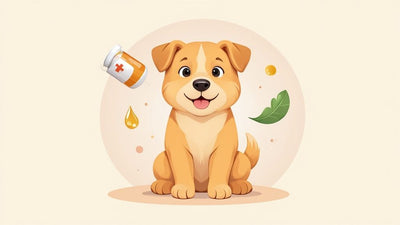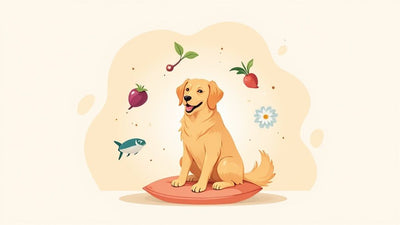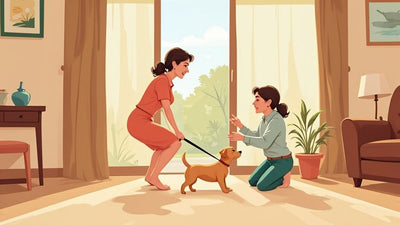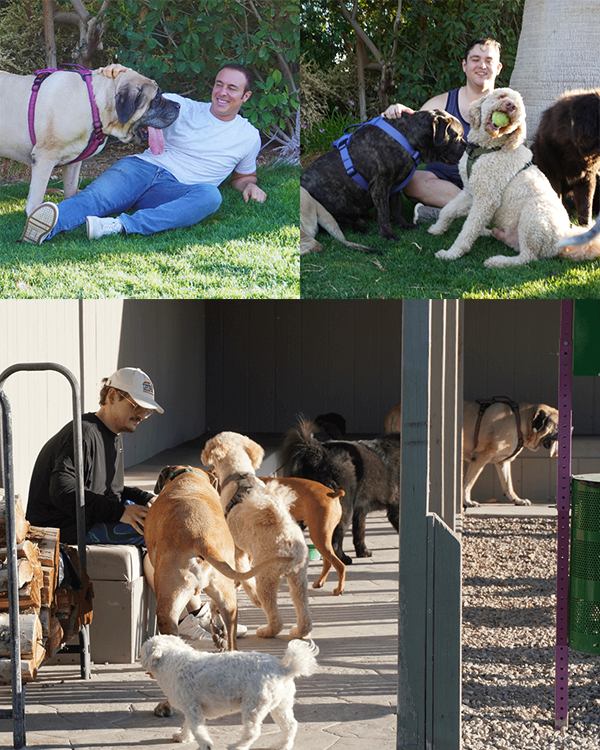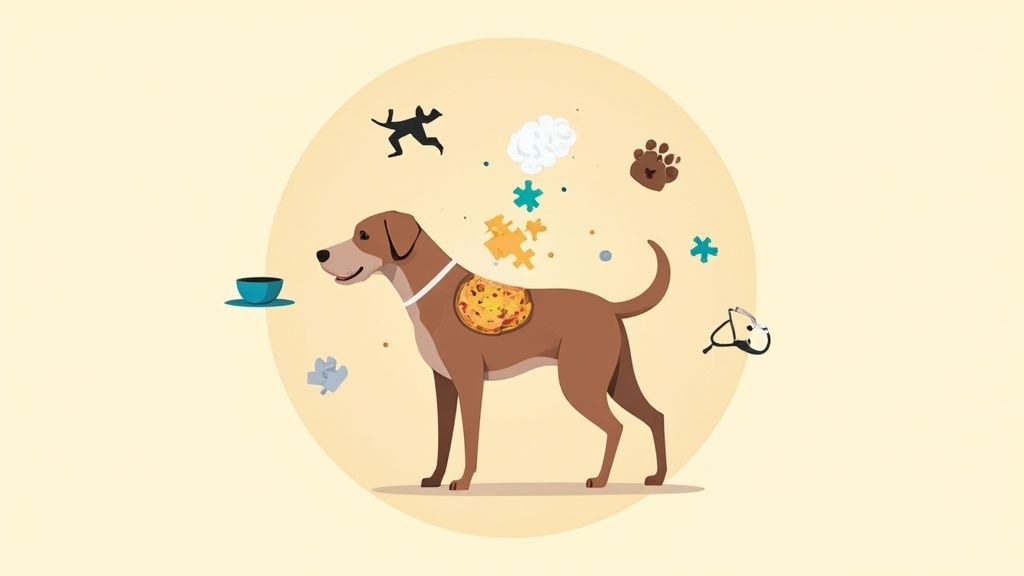
A Guide to Supporting Your Dog Through Cognitive Dysfunction
It can start so quietly. Your dog stands at the water bowl, confused about why they're there. Those small moments can feel unsettling, even heartbreaking. But understanding what's happening is the first step in supporting your best friend through their golden years with comfort and grace.
Recognizing the Subtle Signs of Dog Dementia
It often begins with something you almost miss. A moment of hesitation. Your dog, who has known the layout of your home for a decade, suddenly stands at the hinge side of the door, waiting for you to open it. Or maybe on your daily walk, they get a little lost on a familiar path and look up at you with a flicker of confusion.
We understand. Those moments are unsettling and can lead to those 3 AM internet searches, wondering if this is just "old age" or something more. You're not alone on this journey.
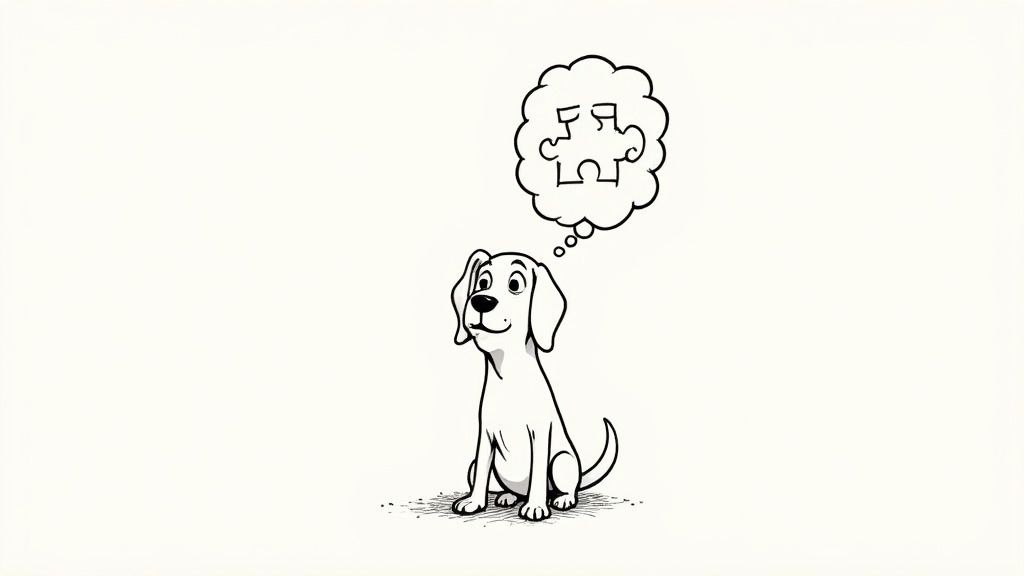
These behavioral shifts are often the first whispers of canine cognitive dysfunction (CCD), a condition that mirrors what happens in the human brain as it ages. It’s more than just slowing down—it’s a genuine change in brain health that needs our gentle attention and proactive support.
The DISHAA Framework: A Gentle Guide to Your Dog’s Behavior
To help families make sense of what they're seeing, veterinarians often use the acronym DISHAA. Think of it as a simple checklist to help you organize the changes you’ve noticed. This framework makes it much easier to have a supportive conversation with your vet and track your dog's progress over time.
To help you identify the subtle changes you might be noticing, here’s a quick reference guide.
Common Signs of Canine Cognitive Dysfunction (DISHAA)
| Category (DISHAA) | Behavior You Might See |
|---|---|
| Disorientation | Seems lost in familiar places, stares at walls, gets stuck in corners, or can't find their food bowl. |
| Interaction Changes | Becomes less interested in petting or greeting you. Some dogs become needier and more clingy. |
| Sleep-Wake Cycle | Paces restlessly at night but sleeps more during the day. May bark or whine for no reason after dark. |
| House-Soiling | Forgets house-training and starts having accidents indoors. |
| Activity Level Changes | Wanders aimlessly, paces back and forth, or shows less interest in exploring or playing. |
| Anxiety | Shows new fears of familiar people or places. Develops separation anxiety or a new phobia (like thunder). |
Having this list helps you connect the dots between seemingly random behaviors. It’s not just one thing; it's a pattern that tells a story.
A Common Journey for Senior Dogs
It’s important to know just how common this is. The likelihood of a dog developing CCD increases significantly with age. One study found that while 8.1% of dogs aged 8 to 11 showed signs, that number rose to 67.3% for dogs between 15 and 17 years old.
This means you are part of a huge community of dedicated dog parents navigating the exact same path.
By understanding these dog dementia warning signs NeuroChew can help with, you can turn this challenge into a chance to deepen your bond. The goal isn't to turn back the clock, but to help you and your dog have more good days together.
Get Your FREE Dog Brain Health Guide

Get instant FREE access to today's top ways to help your best friend live a longer, healthier, happier life.
- 39 value-packed pages of expert insights
- Early-detection tips for cognitive decline
- Top brain-boosting superfoods
- Vet-approved mental sharpness strategies
- Fun IQ tests for your dog
A Simple Look Inside Your Dog's Aging Brain
When you see your loyal friend pause, looking lost in a room they've known for years, it’s natural to wonder why. The changes you're seeing aren't just quirks of old age; they're rooted in real, biological shifts happening inside their brain.
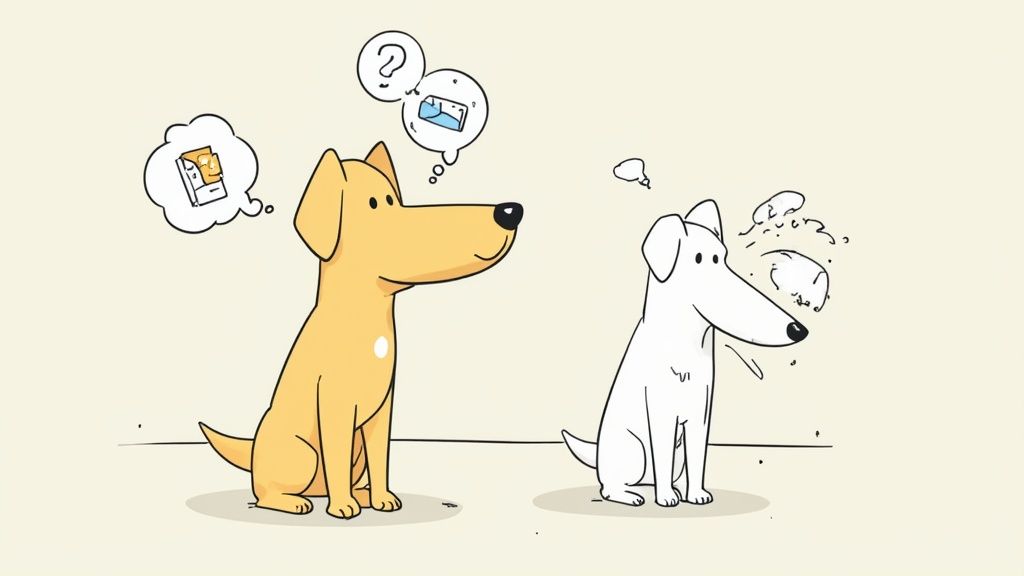
Imagine your dog's brain as a busy city, buzzing with communication lines. For years, everything ran like clockwork. But now, with age, some of those communication lines—the neural pathways—are getting a little frayed. The delivery routes that carry vital oxygen and nutrients are getting a bit slower.
This slowdown isn't caused by just one thing. It's a mix of a few interconnected processes. Getting a handle on what's going on under the surface can help you feel more empowered to help.
The Impact of Natural Wear and Tear
A big part of the story is something called oxidative stress. It sounds complex, but think of it as the natural "wear and tear" on brain cells from a lifetime of hard work. Just like a car's engine parts wear down from use, brain cells accumulate a bit of damage from their high-energy job.
Over the years, this process can make brain cells less efficient at talking to each other. This is where supporting the brain with antioxidants can be helpful, to help manage this natural process.
Another factor is the build-up of certain proteins, like beta-amyloid plaques.
You can picture these plaques as tiny roadblocks that gradually pop up on the brain's communication highways. As more roadblocks appear, they disrupt the flow of information, making it harder for messages to get where they need to go.
This is what can lead to the confusion you see—your dog forgetting familiar routes or struggling with a command they've known forever. It’s not them being stubborn; it’s a physical traffic jam in their neural network.
How Chronic Pain Can Cloud the Mind
We also have to talk about the powerful link between chronic pain and cognitive health. Many senior dogs live with the daily discomfort of conditions like arthritis. When a dog is in constant, low-grade pain, their system is flooded with stress signals.
This persistent stress can directly affect brain function, creating a kind of "brain fog" that can make cognitive issues seem worse. A dog whose attention is consumed by discomfort might appear more confused or disoriented. That's why addressing comfort is a crucial, though often overlooked, part of any plan to support a dog's cognitive function.
Understanding these internal changes helps us see CCD for what it really is: a biological journey, not a behavioral problem. Knowing the "why" shifts our focus from worry to action. It sets the stage for exploring all the ways we can support those vital connections, helping our dogs navigate their golden years with more clarity and comfort. The goal is simple: support the bustling city within.
Building a Multi-Layered Support System for Your Dog
When you’re facing your dog’s cognitive changes, it’s easy to feel like you’re searching for a single solution. The reality, however, is that the best approach is about building a strong, multi-layered support system. Think of it like using several sturdy pillars to hold up a structure you love dearly.
A truly effective plan for supporting a dog with cognitive dysfunction weaves together practical, achievable steps. By focusing on nutrition, mental stimulation, physical activity, and a solid partnership with your vet, you create a powerful synergy. Small, consistent efforts across these areas add up to make a meaningful difference in your dog’s daily comfort and clarity.
This infographic breaks down the main avenues of support you can provide for your senior companion.
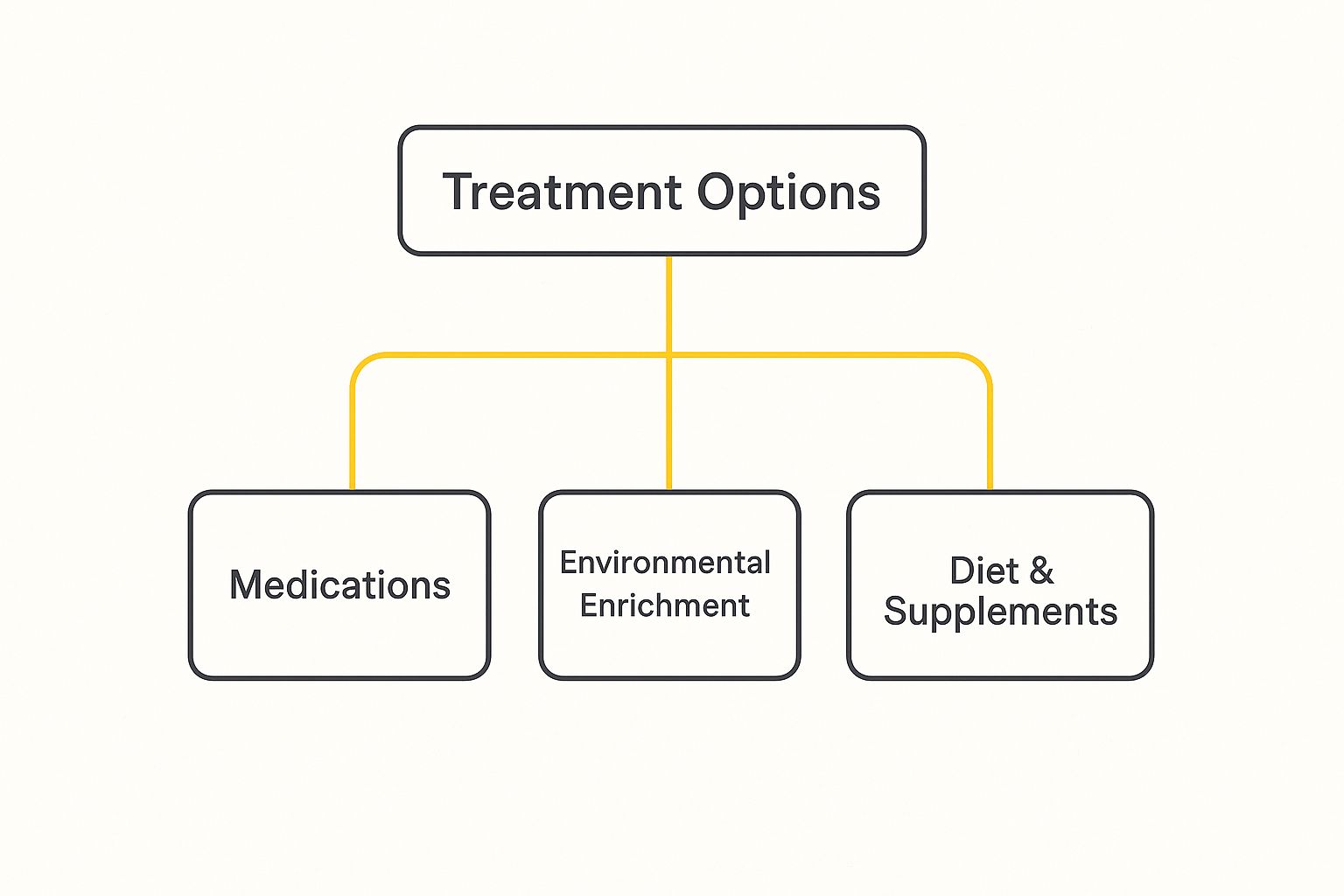
As you can see, a balanced plan is a team effort, combining veterinary guidance, smart dietary choices, and daily enrichment to create a complete safety net for your dog.
Pillar 1: Nutritional Support to Fuel Brain Health
One of the most direct ways you can support your dog’s aging brain is through their food bowl. It’s a bit like giving a complex engine the highest-quality fuel you can find. Certain key nutrients and antioxidants go to work protecting brain cells and shoring up the communication pathways that naturally slow down with age.
This is all about being intentional with their diet. Whether you choose a specialized senior food or add targeted supplements, nutrition is the bedrock of your support plan. You're giving their body the right building blocks to maintain cognitive function from the inside out.
Pillar 2: Environmental Enrichment to Keep Their Mind Active
Just like physical exercise keeps a body strong, mental exercise helps keep a mind sharp. Environmental enrichment sounds complicated, but it's really just about creating a world that gently engages their senses and brain. And it doesn't have to be expensive or time-consuming.
A few simple additions can make a huge impact:
- Gentle Puzzle Toys: Things like slow feeders or "snuffle mats" are fantastic. They encourage your dog to use their nose and tap into their natural problem-solving skills.
- Consistent Routines: A predictable schedule for meals, walks, and bedtime can dramatically reduce the anxiety and confusion that often come with CCD. It helps them feel secure.
- Clear Pathways: Keep furniture in the same place and make sure their food and water bowls are always easy to find. This helps them navigate their world with confidence.
These small adjustments help create a calmer, more predictable home where they can thrive.
We know that watching your best friend go through these changes is tough. For a closer look at the symptoms and what they mean, our guide on the early signs of cognitive decline in dogs can offer more comfort and clarity.
Pillar 3: Physical Activity to Support Healthy Circulation
Gentle, regular movement is incredibly important for brain health. It helps maintain healthy blood flow, which is how vital oxygen and nutrients get delivered to the brain. This isn’t about training for a marathon; it’s about consistent, comfortable motion.
Short, frequent walks along familiar routes are perfect for this. Even a bit of gentle indoor play or some simple stretching can boost circulation. The goal is just to keep their body moving in a way that feels good, which in turn helps keep those "delivery routes" to their brain wide open.
Pillar 4: A Strong Veterinary Partnership
Your veterinarian is your most important ally on this journey. Think of them as your co-pilot, helping you create a safe and effective plan that’s tailored specifically for your dog. A thorough check-up is always the first step to rule out other medical issues, like chronic pain from arthritis, which can mimic or worsen the signs of CCD.
Your vet can help you navigate all the available options, from diet and supplements to prescription medications if they become necessary. Working together, you can build a plan that addresses your dog's health from every angle. This partnership gives you the power to make informed, confident decisions for the friend who has given you a lifetime of love.
Using Nutrition to Support Your Dog's Cognitive Health
What you put in your dog's bowl can be a powerful and loving part of your strategy for supporting them through canine cognitive dysfunction. It's one of the most proactive steps you can take, offering gentle, daily support to their aging brain. You're not just feeding them; you're providing the essential building blocks they need to maintain clarity and comfort.
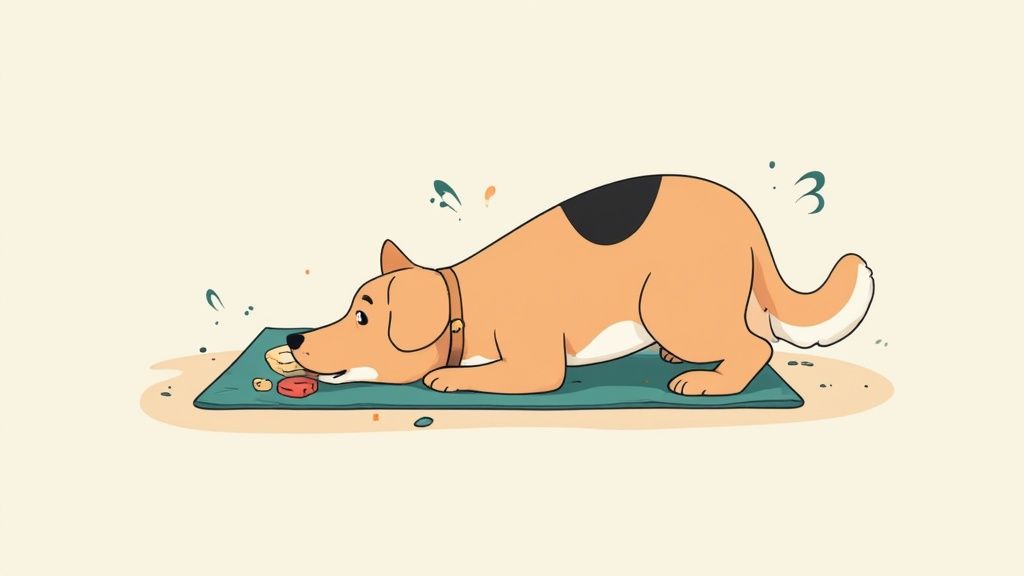
This approach is all about fueling their brain with specific nutrients that help protect cells and support the vital communication lines that can slow down with age. Vets and researchers often focus on managing oxidative damage and supporting neurotransmitter levels, which makes nutrition a foundational pillar of care. If you want to dive deeper into the science, you can explore the latest research on canine cognitive support on frontiersin.org.
Brain-Boosting Ingredients to Look For
Navigating food and supplement labels can feel overwhelming, but a few key ingredients consistently stand out for their ability to support brain health. When you're choosing a food or supplement, keep an eye out for these powerful components.
- Antioxidants (Vitamins C & E): Think of these as your dog's personal cellular bodyguards. They help protect brain cells from the "wear and tear" of oxidative stress that naturally accumulates over a lifetime.
- Omega-3 Fatty Acids (DHA & EPA): These healthy fats, often found in fish oil, are crucial for maintaining the structure of brain cell membranes. This helps ensure messages can flow smoothly between neurons.
- Medium-Chain Triglycerides (MCTs): Typically from coconut oil, MCTs provide an alternative energy source for the brain that aging brain cells can often use more easily than glucose.
Combining this kind of cellular protection and alternative fuel can make a meaningful difference in your dog's daily alertness and engagement.
"We understand the journey of loving an aging dog. Focusing on their nutrition is a tangible way to show your love, helping to support their cognitive health one meal at a time. Small improvements matter, and they often start from within."
Translating Science Into Simple Support
Some of the most effective brain-support ingredients have complex scientific names, but their functions are beautifully simple. For instance, Phosphatidylserine is a key ingredient for "brain cell support." It helps maintain the flexibility of brain cells, which is essential for memory and learning.
Another great example is Huperzine-A. This compound helps support the levels of acetylcholine, a neurotransmitter that’s vital for many cognitive processes. It's all about making sure the brain has what it needs to keep its communication network running as efficiently as possible. For a broader look at how diet impacts senior dogs, check out our guide on nutrition and supplements for aging dogs.
Here's a quick summary of how some of these key nutrients contribute to your dog's overall brain wellness.
Key Nutrients for Brain Health Support
The right combination of nutrients can offer comprehensive support for an aging mind. Below is a simple breakdown of some powerful ingredients and how they help.
| Nutrient/Ingredient | How It Supports Brain Health |
|---|---|
| Phosphatidylserine | A natural building block that supports brain cell structure and function, which is crucial for memory. |
| Omega-3s (DHA/EPA) | Helps maintain healthy brain cell membranes and promotes good blood flow to the brain. |
| B Vitamins | These vitamins are essential for producing energy within brain cells and supporting nerve function. |
| Huperzine-A | Supports the levels of neurotransmitters that are important for learning and mental clarity. |
These ingredients work together to protect brain cells, provide energy, and ensure the lines of communication stay open.
A Gentle Approach with NeuroChew
This is exactly why we created NeuroChew. It brings together these research-backed ingredients into one simple, daily chew. We've combined key elements like Phosphatidylserine for brain cell support and Huperzine-A to promote mental clarity, all in a gentle, natural formula.
It’s a steady, reliable way to support your dog's brain health day in and day out. Many families tell us they see their dogs become more alert and engaged again—maybe they start sleeping through the night or show renewed interest in their favorite toys. It’s all about creating the conditions for more good days, together. While many dogs show meaningful improvement, every dog's journey is unique. Results may vary.

Support Your Dog's Brain Health with NeuroChew™
As mentioned in this article, NeuroChew is the first dog chew designed to support both cognitive function and healthy circulation. Perfect for dogs showing early signs of cognitive decline or for proactive brain health support.
Exploring Veterinary Options and Medical Support
When you're navigating something as complex as your dog’s cognitive health, your veterinarian becomes your most important ally. Think of them as your partner in this journey, bringing medical expertise to combine with your deep, personal knowledge of your dog. Working together is how you’ll build a plan that truly supports your aging friend.
The first thing your vet will want to do is a complete physical exam. This step is so important. Why? Because other health problems can mimic the signs of CCD. Things like arthritis pain, failing eyesight or hearing, or kidney issues can cause confusion, anxiety, or changes in behavior. We have to rule those out first to make sure we're supporting the right thing.
Prescription Support for Cognitive Health
If the diagnosis is indeed CCD, your veterinarian might bring up the topic of prescription medications. It’s important to understand that these are tools designed to help the brain's internal wiring work a little better. They fit into the bigger picture, supporting the diet, supplement, and lifestyle changes you’re already making.
A common medication you might discuss is selegiline. It works by supporting the levels of dopamine, a critical chemical messenger in the brain. Think of dopamine as the brain's "feel-good" and "get-up-and-go" signal—it helps regulate mood, motivation, and movement. All of these can be affected by CCD.
By helping to maintain those dopamine levels, selegiline can often bring noticeable improvements. Many owners report better sleep cycles, more interest in interacting with the family, and a general boost in alertness. It’s a gentle way to help the brain find a bit of its old balance.
Understanding the Role of Medical Intervention
It’s completely normal to feel a mix of hope and apprehension about starting your dog on medication. We get it. The goal here isn't to reverse the clock, but to help manage the symptoms and, most importantly, give your dog more good days.
Small improvements can mean the world. Success isn't always a dramatic turnaround. Often, it’s a quiet night without pacing, a moment of clear recognition in their eyes, or the simple joy of them greeting you at the door again.
Targeted medical support can make a difference. For example, clinical studies have shown that certain drugs can improve cognitive scores in dogs with CCD. In one particular study, dogs receiving medical treatment showed meaningful improvement over six months, while dogs who weren't treated continued to show further changes. This kind of research, which you can read more about at Nature.com, shows just how powerful these interventions can be in maintaining quality of life.
Creating a Collaborative Care Plan
Your role in this is absolutely vital. You see your dog every single day. You know their quirks, their habits, and what’s “normal” for them. The observations you bring to the table are the most valuable pieces of information your vet has.
To make your vet visits as effective as possible, try these simple things:
- Keep a Log: Jot down any new or worsening behaviors. When did the pacing start? Is the anxiety worse at a certain time of day?
- Take a Video: It’s one thing to describe a confusing behavior, but it’s another to show it. A quick video on your phone can be incredibly helpful for your vet.
- Ask Questions: Never be afraid to ask for clarification. How does the medicine work? What should I watch for? What are our next steps?
You are your dog’s greatest advocate. By teaming up with your veterinarian, you ensure every piece of the puzzle—from nutrition and enrichment to medical therapies—is working together. This partnership gives your best friend the best possible chance to navigate their golden years with comfort and dignity.
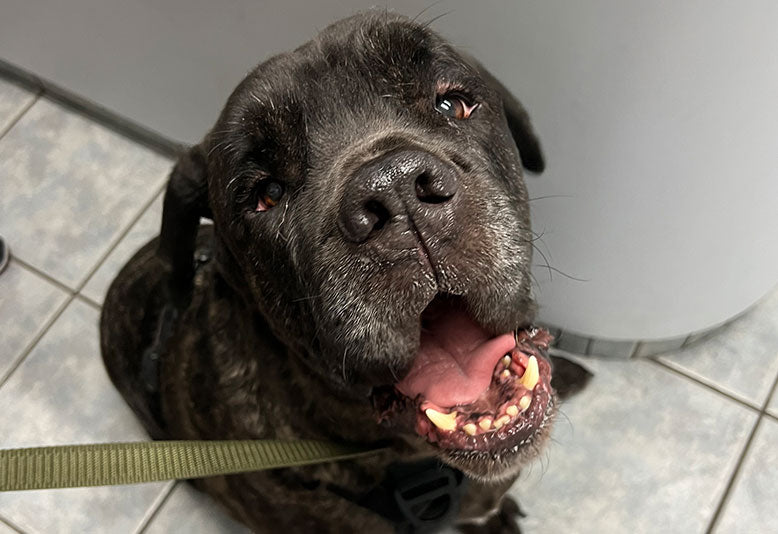
Real Results: How NeuroChew Helped Brutus Regain His Mental Clarity
Brutus was getting disoriented at night. After starting NeuroChew, he's more happy during the day and steady at night. He's back to his old self!
Celebrating Small Wins on Your Journey Together
When you’re walking this path with an aging dog, it’s easy to get caught up in the big picture—watching for changes, hoping for improvements, and worrying about the future. But the real victories in supporting cognitive health are often small, quiet, and profoundly meaningful.
The journey is about the peaceful night's sleep, finally free from anxious pacing. It's the flicker of recognition in their eyes when you come home, that little sign that tells you they feel safe with you. Or maybe it’s the gentle tail wag when they rediscover an old, forgotten toy, a spark of their younger self shining through for a moment.
These are the moments that truly matter. These are the small wins. They can shift your entire perspective from one of anxiety to one of hope.
Finding Joy in the Little Things
You are absolutely not alone in this. We hear from families every single day who share these kinds of victories, and they are worth celebrating. They're a testament to your love and all the effort you're putting in.
Here are a few examples of the progress other dog parents have treasured:
- Renewed Interest in Meals: A dog who seemed lost at their food bowl now eats with enthusiasm.
- Greeting at the Door Again: That moment they remember the old routine and are waiting for you, tail wagging.
- Navigating the House with Confidence: They aren't getting stuck in corners as much and seem to move with more purpose.
- Engaging with the Family: Choosing to curl up near you instead of isolating themselves in another room.
Each of these is a beautiful signal that the support you’re providing is making a real difference in their comfort and clarity.
"Your dog gave you their best years—now you are giving them yours. We measure success in peaceful nights and moments of recognition, because we know those small improvements can mean everything."
More Good Days Together
Ultimately, this is all about cherishing the time you have together. By consciously focusing on and celebrating the small wins, you change the narrative. You're no longer just managing a condition; you're creating the opportunity for more good days together.
Every gentle nuzzle, every peaceful nap, and every shared moment of connection is a victory. Your love is the one constant they can always rely on, even when their world feels confusing. Supporting them so they can feel more like themselves again is one of the greatest gifts you can offer. You are doing an amazing job.
Frequently Asked Questions
We know how it feels. When you're facing a diagnosis like this, the questions can feel overwhelming. You’re not just looking for information; you’re looking for hope and practical steps to help the dog you love. Let's walk through some of the most common questions we hear from pet parents just like you.
How Quickly Might I See Improvements?
It's natural to want to see a change right away, but every dog's journey with cognitive decline is different. With a consistent plan that includes good nutrition, mental enrichment, and supportive supplements, many families report seeing small but meaningful shifts within 4 to 6 weeks. This might look like more restful sleep through the night or moments of sharper alertness during the day.
For others, the progress is slower and more subtle. The key really is consistency. Think of this as a long-term strategy to support their brain health, not a quick fix. It’s all about creating more good days and celebrating every small victory along the way.
Can I Combine Supplements with Vet Medication?
This is such an important question, and the answer is simple: always talk to your vet first. Your veterinarian is the most crucial member of your dog's care team.
While many natural supplements are designed to be compatible with traditional veterinary treatments, your vet needs the full picture. They can look at the ingredients in a supplement like NeuroChew and weigh them against your dog’s specific health profile and any medications they're currently taking. This teamwork ensures everything works together safely, creating the best possible plan for your best friend.
What Can I Do at Home to Help?
So much! The small, consistent things you do at home can make a world of difference in easing your dog's anxiety and confusion. Creating a stable, supportive environment is one of the most powerful tools you have.
Here are a few simple ideas that have a big impact:
- Stick to a routine: Dogs thrive on predictability. Keeping meals, walks, and bedtime on a regular schedule provides a comforting sense of security.
- Keep their world consistent: Avoid rearranging the furniture. Make sure their bed, water bowl, and food are always in the same easy-to-find locations.
- Offer gentle enrichment: Simple puzzle toys or a snuffle mat can engage their brain in a low-stress, rewarding way.
"We measure success in peaceful nights and moments of recognition. The small changes you make at home are a huge part of creating those moments, reinforcing the incredible bond you share and supporting their overall well-being."
These daily acts of love are a cornerstone of any effective plan for supporting a dog with cognitive dysfunction.
At Furever Active Ranch, we're here to support you on this journey. Our NeuroChew supplement was created to provide gentle, natural support for your dog's brain health, helping to promote mental clarity for more good days together. Discover the difference NeuroChew can make.
Share This Article

Support Your Dog's Brain Health with NeuroChew™
The first dog chew that supports both brain function and healthy circulation. Perfect for dogs of all ages.
- Enhances cognitive function & mental clarity
- Reduces anxiety without sedation
- Supports healthy blood circulation
- Made in USA with natural ingredients
60-Day Money-Back Guarantee • Free Shipping



